The Food of Aleppo
The ancient city of Aleppo (Halab – Alep) prides itself on the best cuisine in the Middle East. Such a reputation often intrigues travelling gourmands so before departing on our trip to Syria, I consulted Aleppian people in the know and collated a list of food and drink they considered to be a speciality.
The food of the Levant is rich and diverse. Variations on a dish exist between Middle Eastern countries that line up the eastern Mediterranean sea. It’s not uncommon for one country to own a dish and have it adopted by its neighbour. With Aleppo‘s proximity to Turkey and sharing a border with Lebanon, many dishes have mixed origins, much like the Armenian influences which have punctuated the city’s cuisine.
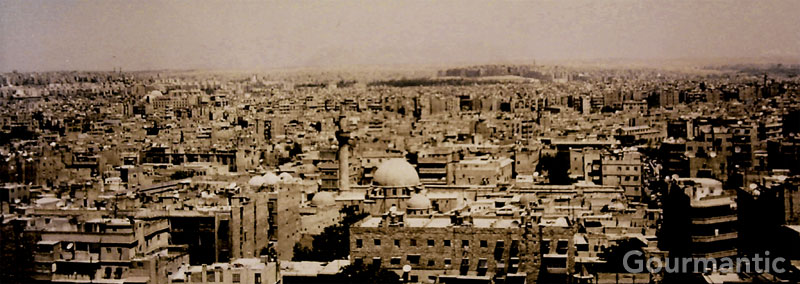
This comprehensive guide is divided into three sections: Food, Drink and Sweets with dishes listed in alphabetical order. Some references are made to the origin of the dish but as I was told during my travels in Syria and Lebanon, when it comes to food, barriers begin to crumble.
Food
This section is subdivided into Mezze, which is a selection of small dishes that are eaten as appetisers or first courses followed by Main Dishes, though the division can get a little blurry at times.

Baba Ghanouj – also known as mtabbal, this is a popular chargrilled eggplant dip made with Tahini and lemon juice.
Basturma – air-dried cured beef surrounded with chaman, a pungent spice. Armenian in origin. Well worth the resultant bad breath. Also known as bastirma, basturma, pastirma.
Fattoush – a tangy salad that includes tomatoes, cucumber, purslane, toasted pieces of Arabic bread and seasoned with sumac.
Foul Medammas – After a very late night out, head out at 5 am to a fawwal, an eatery that serves foul medaddas for breakfast, cooked fava beans in olive oil, lemon juice onion, garlic and cumin. Very popular dish in Egypt.
Hommos – a popular dip found in other parts of the Levant, made with chickpeas, Tahini and lemon juice.
Jibneh mshallaleh – also known as Syrian String Cheese
Labneh – a plain yoghurt style dip, drizzled with olive oil and eaten with Arabic bread
Lsanat – Lamb tongue stuffed with pistachio and cooked with water and vinegar
Mhammara – a dip made with red peppers, walnuts and pomegranate molasses (called dibs romman), cumin, olive oil and bread crumbs.
Mortadella Halabiya – very fine ground beef called Habra mixed with spices, garlic, pine nuts, peeled pistachios then rolled into a thick sausage shape. The meat is smoothed by hand then boiled in water and vinegar. Cut into rounds and served cold. (see photo)
Shanklish – a type of cow or sheep milk cheese, rolled into a ball and covered with spices. Served crumbled with olive oil added. Eaten with Arabic bread.
Toum – a potent garlic dip, so light in texture and strong on taste that it will get you addicted. A dip I often associate with the food of Lebanon rather than Syria.
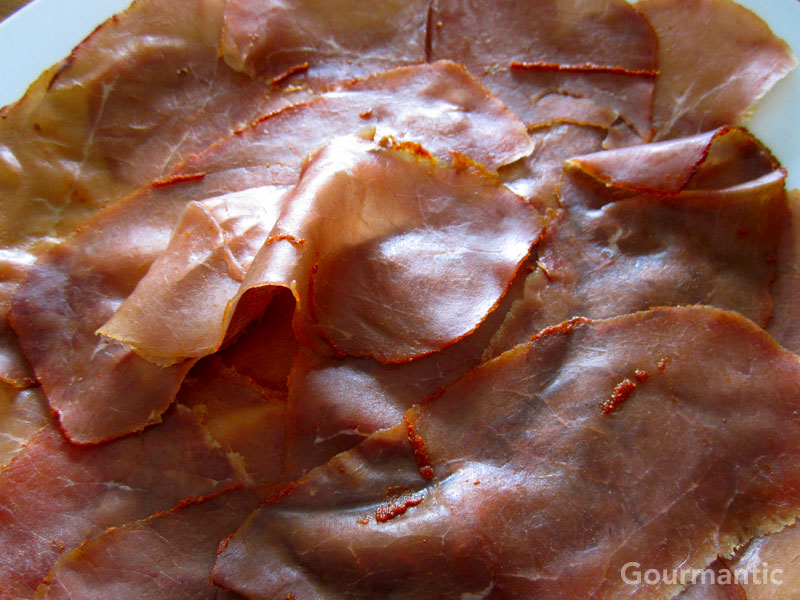


(L) Basturma (M) Mortadella halabiya (R) Jibneh Mshallaleh
Freekeh – a type of greenwheat much like roasted burghul, cooked with chicken (or lamb), onions and sometimes chick peas. (favourite)
Kabab bil Karaz – the speciality dish of Aleppo. Lean minced meatballs cooked with small sour cherries (wishna) and spices. Served on pieces of Arabic bread cut in triangles and scattered with pine nuts and parsley. (favourite)
Kamayeh – a Syrian truffle that is found in the desert. Like other truffles, it is expensive and rare. Look out for it in Syrian cuisine. This is one ingredient I would love to try.
Kibbeh Nayyeh – this is the raw version of kibbeh, made with minced lamb or beef mixed with fine burghul, onion and spices. Kibbeh Nayyeh is also the foundation of other kibbeh dishes.
Kibbeh bil Sayniyeh – baked kibbeh in a tray. Raw kibbeh is laid in a round tray, topped with a layer of cooked minced meat with spices and pine nuts, then topped with another layer of raw kibbeh. The whole dish is cut into diamond shapes, baked in the oven and served hot (see photo)
Kibbeh Blabanieh – kibbeh cooked with plain yoghurt, traditionally eaten in the New Year as it is a dish white in colour
Kibbeh Bsafarjaliyeh – cooked kibbeh made with quince pieces
Kibbeh Bshahme – kibbeh rounds are shaped into a dome and filled with pieces of fat (see Liyeh/Dehneh) and mixed spices. The kibbeh is then baked or fried which melts the fat inside it. It must be eaten hot before the tasty fat solidifies. One for connoisseurs. (favourite)
Lahm Baajeen – An Armenian dish in origin, a mixture of minced meat, tomatoes, garlic, green peppers, onions, parsley, spread on a thin dough and baked in a hot oven. The Syrian version uses meat, onions and dibs romman or pomegranate molasses. (favourite)
Liyeh or Dehneh – this is in essence lamb fat which is used in Aleppian cooking. It comes from a special type of sheep with fat in the tail and the rump region.
Makanek / Sujok – small, thin home-made sausages mixed with a special blend of spices, served grilled or fried.
Me’lak – barbecued liver pieces with coriander and other spices.
Meshwi with Liyeh – lamb fillets barbecued in skewers with pieces of Liyeh (fat from a type of sheep that has a fat sac near its tail). The pieces of fat melt in the mouth releasing a tasty flavour. (favourite)
Sendmanat – thick beef sausage made with rice, whole chickpeas and spices. The sausages are boiled first, then fried in oil to give them a little crunch. Also known as Mombar or Ebewat.
Yabraq – vine leaves rolled as cigars and stuffed with rice and meat then cooked slowly in water and lemon, garlic. Served hot.
Yalanji – thin eggplants stuffed with rice and cooked with pomegranate juice. Served cold.


(L) Kabab bil Karaz (R) Kibbeh Bil Sayniyeh
Drinks
Ambariyet El Karaz – a liqueur made by infusing sour cherries (wishna) in Arak, cloves and sugar. An aromatic digestive, served in a small glass with the unpitted cherries. You drink the liqueur then pop the cherry in your mouth. Here’s a recipe on how to make ambariyet el karaz at home. (favourite)
Arak – the traditional alcoholic drink enjoyed as an aperitif and an accompaniment to mezze and main courses. The aniseed- flavoured distillate is made from grapes. Water is added to the colourless liquid which turns it into a milky colour. (favourite)
Ayran – Turkish in origin, this drink is essentially a liquid yoghurt whose flavour is enhanced by adding a little salt. A cool refreshing drink that is also sold in bottles. An acquired taste if you don’t like the plain yoghurt taste.
Ahweh with hab el hal / Arabic coffee with cardamom – Traditionally, cardamom pods are boiled with water until they pop then coffee is added. More commonly, powdered cardamom is added to ground coffee before it is made. The coffee is served with no sugar. It has a slightly bitter taste but very aromatic. (favourite)
Erk sous – a drink made with liquorice root. Has a dark coffee colour and tastes bittersweet. Look out for a sawwas, the juice vendor often dressed in traditional clothing, carrying a brass utensil which he clicks to serve it.
Jallab – reddish in colour, this drink is made fromgrape molasses, rose water, dates and a little syrup. Often served with crushed ice garnished with pine nuts and pistachios. A Lebanese drink also popular in Syria.
Sharab el Toot – mulberry syrup, a tiny amount is added to a glass then topped with cold water and ice cubes.
Sharab el Ward – a pink syrup made from rose petals, with sugar, water, a special pink colouring added. A tiny amount is added to a glass then topped with cold water and ice cubes. A refreshing summer drink with a delicate rose flavour.
Sweets
Many sweets aren’t found all year round. Some are prepared specially for religious holidays such as Ramadan, Easter, Christmas and New Year.
Amardeen – large sheets of apricot paste, sticky and sweet, eaten as a snack. Much like an apricot bar but without all the preservatives.
Armouch – a meringue biscuit made with crushed walnuts, cinnamon and cloves and egg whites. Crunchy and aromatic.
Barazek – a specialty of Damascus, these are flat round biscuits made with pistachios, sesame seeds and mahlab. They pack a crunch and if you like pistachios, you can’t stop at one (favourite)
Basteek – sheets of grape paste, spread on fabric, dried, sprinkled with icing sugar. (favourite)
Bzourat ice cream – made with ground and toasted yellow melon seeds, this ice cream is dark in colour, rich in flavour, often served with a vanilla ice cream to soften the taste. (favourite)
Ghazl el banat – Arabic fairy floss wrapped into a ball and filled with pistachios, made during Ramadan. Also known as pismaniye in Turkey and pashmak in Iran. (favourite)
Ghraybeh stambouliyeh – oval shaped sweets that remind me of a boat. Made with almonds paste and sugar, they’re baked as biscuits then joined with a chocolate or pistachio glazing.
Haytaliyeh – like a blancmange dessert, set in water, cut into square pieces, served in a liquid syrup and flower water and finely crushed ice. A refreshing summer dessert. Sometimes, it has a caramelised milky flavour though I was unable to learn how it is made.
Jo’ malban – sheets of grape (see Basteek) rolled around walnuts and threaded into a string.
Kaak Bi Loz – much like baked marzipan, these are fingers of fine almonds, sugar and orange flower water. I bought a box back with me from a patisserie called Azrak in Aleppo. (favourite)
Karabeej Halab with Natef – dough pieces made with semolina, a little flour and gheefilled with pistachio or walnuts. This is topped with Natef, a meringue-like topping made with syrup, egg whites and soapwort root. Sprinkled with cinnamon on top. (favourite)
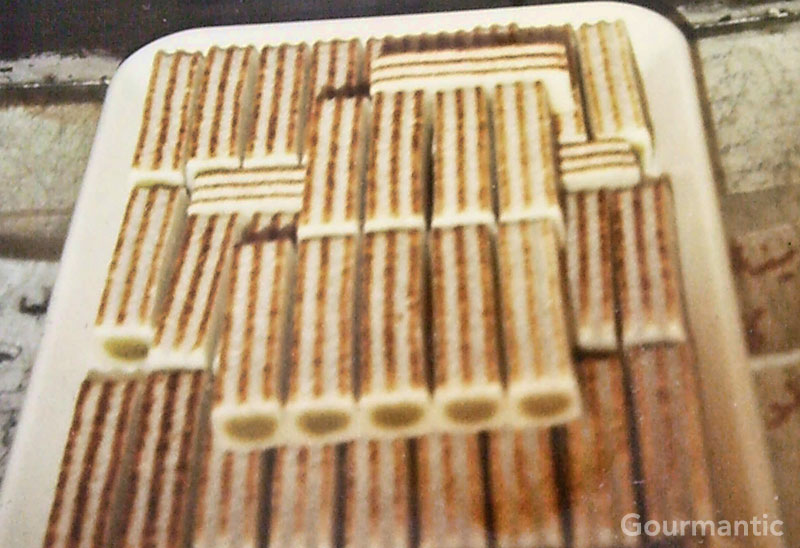
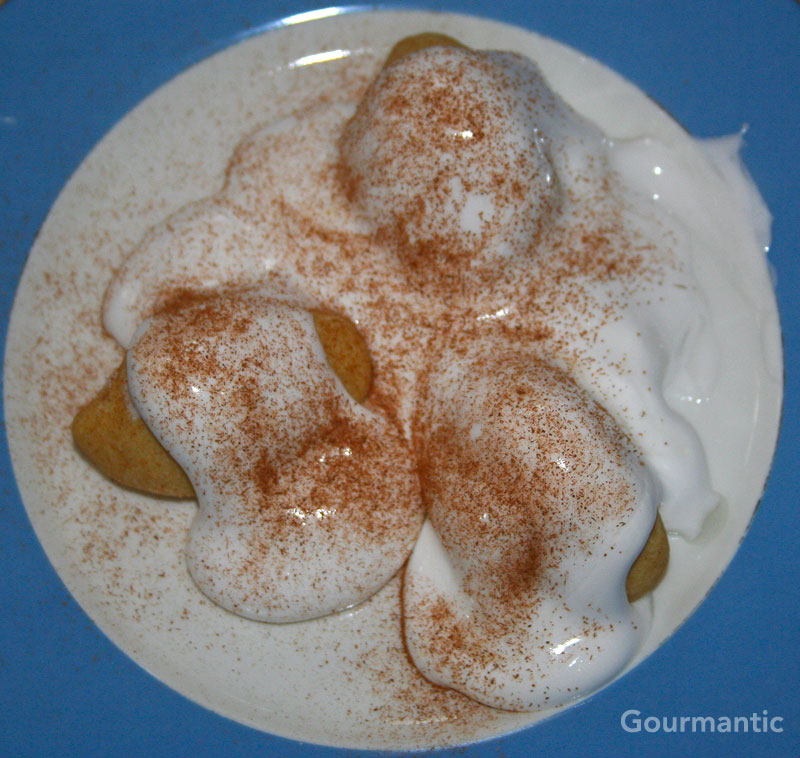
(L) Kaak Bi Loz (R) Karabeej Halab with Natef
Kleeja – cake pieces with a mix of aromatic spices such as cinnamon, cardamom, cloves, numeg, mahlab, cardamom. (favourite)
Knafeh Bassma / Balloriyeh – very thin kind of white knafeh filled with pistachio, cooked in oven then cut into squares and topped with syrup.
Lo’m el Adi – as with mshabbak but these are made into small balls and fried in oil. Syrup that is flavoured with flower water is added on top.
Mamouniyeh – a sweet breakfast dish like porridge made with semolina, sugar, water and ghee and cinnamon
Mrabba el Batinjan – made with mini eggplants that have been treated with lime water to give them a crunch. They’re stuffed with pistachios, sugar and macerated in syrup with cloves. (favourite)
Mrabba el Joz – same as mrabba el batinjan but made with whole walnuts
Mshabbak – dough thinned with water, made into a spiral or a snake shape, fried in oil, then syrup added. Meaning entangled.
Zlebiyeh – made with batter like a pancake, then sprinkled with sugar, cinnamon and crushed pistachios, these are also eaten for breakfast (favourite)

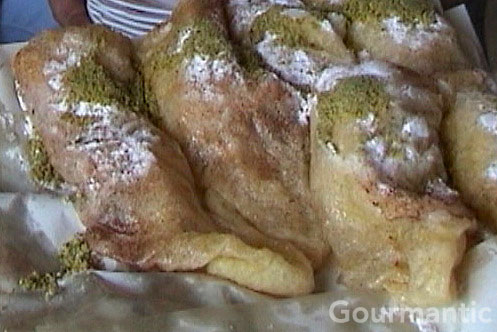
(L) Mrabba el Joz (R) Zlebiyeh
If you’re planning a visit to Syria, make sure Aleppo is on your travel itinerary. With such a variety of foods on offer, this culinary capital deserves more than just a passing visit.


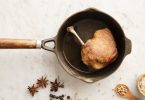

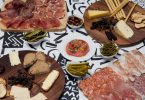

[…] more information about Aleppo’s food, don’t miss our food and drink guide: What to Eat in Aleppo Syria Ms Gourmantic has a strong penchant for packing a laptop, a digital SLR, a large suitcase and […]
[…] more information about Aleppo’s food, don’t miss our food and drink guide: What to Eat in Aleppo Syria Ms Gourmantic has a strong penchant for packing a laptop, a digital SLR, a large suitcase and […]
[…] more information about Aleppo’s food, don’t miss our food and drink guide: What to Eat in Aleppo Syria Ms Gourmantic has a strong penchant for packing a laptop, a digital SLR, a large suitcase and […]
Wow, this is truly comprehemsive! As a blogger, I know what kind of effort went into putting this together, so thank you!
Thanks Jen! I was going through my travel notebooks and found this list. Turns out I was a travel/food blogger from way back! 🙂
[…] This post was mentioned on Twitter by Ms Gourmantic, Ms Gourmantic. Ms Gourmantic said: What to Eat in Aleppo Syria: A Food and Drink Guide: The Food of Aleppo The ancient city of Aleppo prides itself o… http://bit.ly/cuNBwx […]
LOVE Syria. And could eat Middle Eastern food most every day.
Great place to visit, isn’t it… Sadly, tourism is practically non existent.
I love the food of the Middle East, always layered with deep flavour and often vegetarian friendly.
True. There are so many vegetarian options yet they’re not bland or boring. I found the produce to be so fresh and flavoursome!
RT @Gourmantic: What to Eat in Aleppo Syria: A Comprehensive Food and Drink Guide .
This comment was originally posted on Twitter
Wow! Great food guide to Syria RT @Gourmantic: Food and drink of Aleppo Syria: A Comprehensive Guide http://bit.ly/ai9Xj9 #aleppo #syria #tt
This comment was originally posted on Twitter
RT @foodloverkathy: Wow! Great food guide to Syria RT @Gourmantic: Food and drink of Aleppo Syria: A Comprehensive Guide https://gourmantic.com/2010/10/19/what-to-eat-in-aleppo-syria-a-food-and-drink-guide/ #aleppo #syria #tt
This comment was originally posted on Twitter
This food sounds amazing. I can’t wait to go to the Middle East and eat my way through the region! Thanks so much for giving us such an extensive list of food for our future reference.
You’re welcome 🙂 And I hope you find this post useful in your travels!
RT gourmantic: What to Eat in Aleppo Syria: A Comprehensive Food and Drink Guide http://bit.ly/ai9Xj9 #aleppo #syria #foodie
This comment was originally posted on Twitter
RT @gourmantic: What to Eat in Aleppo Syria: A Food and Drink Guide – a complete guide
This comment was originally posted on Twitter
RT @gourmantic: What to Eat in Aleppo Syria: A Food and Drink Guide – A very detailed list of what ti eat in Aleppo, Syria.
This comment was originally posted on Twitter
RT @Gourmantic What makes a culinary city? The food and drink of Aleppo Syria: A Comprehensive Guide https://gourmantic.com/2010/10/19/what-to-eat-in-aleppo-syria-a-food-and-drink-guide/ #aleppo #syria #tt
This comment was originally posted on Twitter
RT @theplanetd: RT @gourmantic: What to Eat in Aleppo Syria: A Food and Drink Guide – a complete guide
This comment was originally posted on Twitter
OMG – this is a great primer for food of this region! I’m drooling. (not cool)
Wait till you taste some of those sweets… I was truly hooked on so many of them!
Love that there are so many veggie options here -that is incredibly encouraging since I’m planning a trip there in January with Legal Nomads! 🙂
Excellent! It should be a lot of fun. Syrian people are very welcoming and hospitable. And then there’s the food! 🙂
This post would make a great menu cheat sheet to take along to Syria! I’m especially intrigued by the Arabic fairy floss.
I wish I had a photo of each dish to show you. It’s nothing like the usual fairy floss. The best comparison I can make would be to say it’s more natural than the variety we all know from fetes!
What to eat in Aleppo, Syria by @Gourmantic – thought @WanderingEarl you might find this interesting: http://bit.ly/brCFWQ
This comment was originally posted on Twitter
Excellent, thanks Anil. I’m loving Syrian cuisine so far! RT @foxnomad: What to eat in Aleppo, Syria by @Gourmantic- http://bit.ly/brCFWQ
This comment was originally posted on Twitter
We were in Aleppo in June 2009 and it was amazing. Your blog is pulling a bit at my heartstrings, but I really appreciate all the time you’ve taken to document this. Really brings back some wonderful memories of Syria.
Thank you for the lovely comment, MC. It makes it all worthwhile when we can touch people people around the globe with wonderful travel memories 🙂
[…] covering iconic buildings and the mysterious Through His Eyes: Sydney’s Eastern Beaches gave What to Eat in Aleppo Syria: A Food and Drink Guide a competitive battle. November was an eclectic month which saw Gourmantic’s debut into guest […]
[…] a dish of Aleppo, the food capital of Syria, Mhammara is a hot pepper dip made with […]
[…] Syrian cuisine varies regionally – even a basic shawarma sandwich. I am most familiar with Aleppo cuisine, which is justly considered among the best in the Middle East. I love it all, from its particular […]
[…] artichokes. The flavours took you by surprise, and this dish was a little reminiscent of the Mortadella Halabiya, a specialty of the city of Aleppo in Syria, which is made with pistcahio and spices. The dish […]
Hello. I am from Aleppo . I think you did a very good research to know the types of food in our city. I like your site and I trust it after I see your good work in gathering information about food in Aleppo. and thank very much you for your efforts.
[…] that is offered at Christmas but it is a festive treat. Made of ground almonds and sugar, it is a specialty of Aleppo in Syria but you would rarely find it in home kitchens. The recipe and method are well-guarded […]
[…] the anticipation of receiving barazek from a relative returning from Damascus, the breadth of Aleppo’s cuisine, and the first taste of freekeh at Beit Sissi in Aleppo. Sharon’s book is an inspiration to get […]
[…] sauce, karaz spices, cucumber yoghurt, this hero dish is in fact Kabab bil Karaz, a specialty dish from Aleppo in Syria, previously featured on Gourmantic. Chef Kime’s version uses a combination of […]